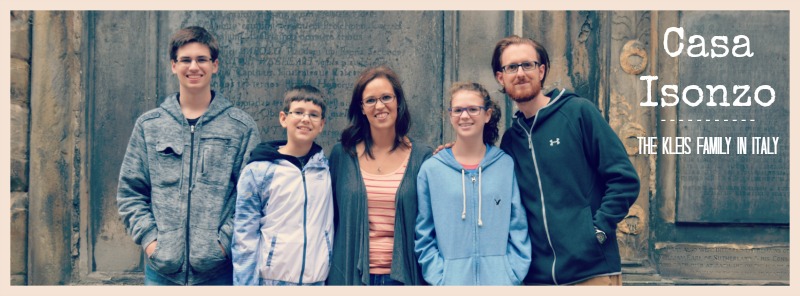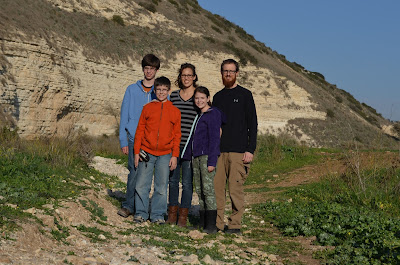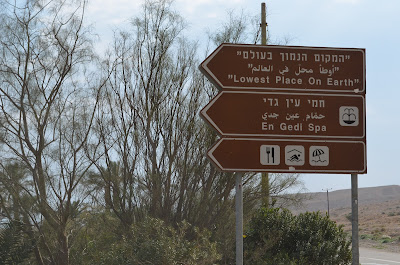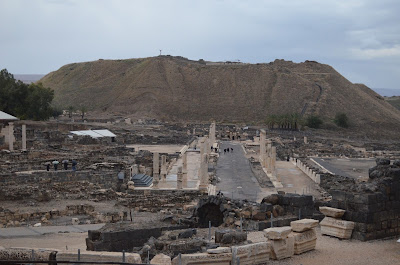In 2015, we had the immense joy and privilege of expanding our network of friendships throughout the world. We cannot tell you enough how the SHARE Family Education Conference we attended for the first time last February in Hungary has opened up doors of mutual encouragement not only for our kids but for us as well. It is so refreshing to be in contact with others who get it, who can immediately relate and commiserate to a life lived overseas, trying to raise kids in a counter cultural and cross-cultural setting. Our dear new friends extended an invite to us to visit and stay with them only minutes after having met them--they live in Jerusalem! Really?! A lifelong dream of Jonathan's to visit Israel was maybe closer to reality than we had ever thought possible. Free housing, encouragement that a self-guided visit to the Holy Land was doable and with airfare prices at low cost, it seemed absurd not to entertain the idea.
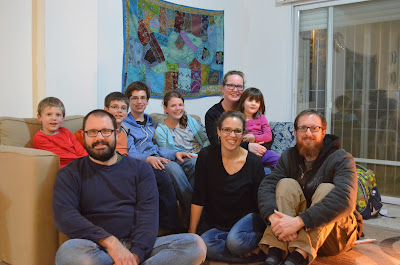 |
| We could not ask for better hosts and friends! Thank you Phil, Angela, Daniel and Hannah! |
Our friends informed us in the fall that they would be moving next summer so we had limited time to make a trip happen. After waiting out fall tensions of increased violence in the country we finally decided to go for it and travel to Israel during the Christmas break. If you read the Christmas post you know that Jonathan was feeling crummy on Christmas day. Our departure was scheduled for December 28. In faith I continued to prepare and pack in hopes that Jonathan would be able to make the trip physically. I will say that it was a gift of God's amazing grace that allowed him to thoroughly enjoy and complete a very intense itinerary that he set out for us to accomplish. I think it was in a way healing to change scenery and to be able to get away. We learned so much as a family, experiencing the richness and reality of God's word come to life!
Now let's be honest, I am extremely overwhelmed about how to even begin to share about this trip since there are over 2,000 photos to sift through! The most I can do is give you a recap of each day with a small peak of what we saw. I hope it is sufficient!
Arrival: Monday, December 28
*The kids were immediately impressed with the Tel Aviv airport and said that "Israel was awesome" right out of the gate. First impressions do count!
DAY 1 : Tuesday, December 29
We got a mid-morning start to our day and took to heart the recommendations from our friends to visit one of their favorite hidden treasure locations that is generally off the tourist radar. Maresha-Beit Guvrin National Park is located in the lower Judean foothills. Tel Maresha ("Tel" is a mound that reveals layers of civilization built one over the other) is the highest city in the area.
It was fortified by King Rehoboam of Judah following the campaign to the region of the Egyptian Pharaoh Shishak: “And Rehoboam...built cities for defense in Judah...Gath, and Mareshah, and Ziph” (2 Chron. 11:5-8).
There were many caves to explore, but one of the most impressive was the Bell Caves.
A series of 80 large caves, which the ancient inhabitants connected by passageways. The caves, the largest of which are over 5 meters high, were dug into the hard surface rock and quarried downward in the shape of a bell. Arabic inscriptions and crosses found on the walls show that many of the caves were dug during the Early Arab period, in the seventh-tenth centuries CE.
We then drove to Lachish.
Lachish is generally regarded as the second most important city in the southern kingdom of Judah. It enters the biblical narrative in the battle accounts of Joshua, Sennacherib and Nebuchadnezzar.
A brief stop in the Valley of Elah allowed us to focus on the story of David and Goliath. We took the liberty of walking along the edge of a field to reach the dry streambed where David chose his 5 smooth stones. Luca seemed really moved after this experience and recounted the entire story to Jonathan again on our walk back to the car.
As the sun was setting we made our way back up to Jerusalem (we discovered why the Bible always speaks of going "up" to Jerusalem!) where we concluded our day with a visit to the Israel Museum. A surprise bonus was that kids were free on Tuesdays! We had entirely too little time to fully enjoy the archeological richness of the museum that boasts a superb collection of artifacts the near totality of which have been unearthed in Israel. We took in what we could with hungry and tired children.
 |
| Holy of Holies from the temple in Arad |
 |
| Ossuary of Caiaphas, the high priest who presided over Jesus' trial |
DAY 2 : Wednesday, December 30
We were out of the house by 6:45am for our day in the South. The drive was spectacular as we headed down (literally) from Jerusalem to the lowest spot on earth. We saw the sun rise over the Dead Sea and the occasional sprinkle then provided us with rainbows to view over the desert landscape.
 |
| Camels at the gas station |
We arrived at Masada as the park was opening. Wow! To quote Lucius Flavius Silva from the miniseries, Masada is "a rock in the middle of a wasteland, on the shores of a poisoned sea!" And that pretty much sums it up.
Masada is a rugged natural fortress, of majestic beauty, in the Judaean Desert overlooking the Dead Sea. It is a symbol of the ancient kingdom of Israel, its violent destruction and the last stand of Jewish patriots in the face of the Roman army, in 73 A.D. It was built as a palace complex, in the classic style of the early Roman Empire, by Herod the Great, King of Judaea, (reigned 37 – 4 B.C.). The camps, fortifications and attack ramp that encircle the monument constitute the most complete Roman siege works surviving to the present day.
 |
| Remains of the Roman encampments |
 |
| The western slope of Masada with the Roman siege ramp |
We did not walk up the snake path to the fortress, but rather opted for the cable car. The magnitude of this location is staggering. We spent several hours on top using a very well written guide map that was provided. We thoroughly enjoyed this mountaintop experience and the opportunity to walk down inside one of the many deep cisterns.
The kids enjoyed the fact that they got to see a wild ibex that was just wandering around the visitor center.
The weather warmed up perfectly for a walk up the Wadi David in the En-Gedi Nature Reserve and National Park. En-Gedi made the kid's top favorite places on the trip. In the middle of the desert there is an oasis of green, fresh water and wild life. The many cascades of waterfalls were beautiful, and our hike culminated at the David Waterfall. You can see why David would have wanted to hide out in this location and write some Psalms here.
The famous discovery of the Dead Sea Scrolls were found in Qumran. A small archeological site made for a quick stop on our return north.
 |
| Mikvah ritual bath |
The Baptismal Site on the Jordan River, Qasr al-Yahud, is the site where according to tradition, Jesus was baptized by John the Baptist and from which Jesus entered the Judean wilderness for 40 days of temptation.
According to various traditions, the site is also believed to be the place where the Children of Israel crossed the Jordan River and entered the Holy Land after their 40 years of wandering in the desert. It here that: “...as soon as the soles of the feet of the priests who bear the ark of the Lord, the Lord of all the earth, shall rest in the waters of the Jordan, that the waters of the Jordan shall be cut off, the waters that come down from upstream, and they shall stand as a heap.” (Joshua 3:13)
Another event attributed to this site is Elijah’s ascension to heaven in a fiery chariot after he and Elisha crossed the Jordan: “Now Elijah took his mantle, rolled it up, and struck the water; and it was divided this way and that, so that the two of them crossed over on dry ground.” (2 Kings 2:8)
 |
| The country of Jordan is on the other bank of the river. |
 |
| Wilderness surrounding the Jordan River |
As it was late in the day, St. George's Monastery was closed but were still able to view it from the lookout point. Bedouins greeted us upon arrival and persuaded us to buy scarfs for the kids and a necklace. I suppose we could have said no, but as it turns out this might be one of my favorite pictures of the kids on this trip. We hopped back in the car just as the rain started to fall.
DAY 3 : Thursday, December 31
The next day we planned to get a tour of Jerusalem and do some shopping with our friends since it was a free morning for them. The weather was forecasted to be rainy all day, but we decided to chance it and head out anyway. And would you know, God put his umbrella over us for the entire morning and afternoon. You will see this being a pattern for the rest of our time. It would rain and rain but immediately clear up when we would get to a site.
Jerusalem deserves a post all its own since we spent a total of 2 1/2 days in the city. However, I will keep this post moving and have to stick to highlights. Phil and Angela guided us to the Western Wall, Cardo Maximus, Broad Wall, and Church of the Holy Sepulchre before taking us to the best shops where we would not get ripped off in the Old city.
 |
| The Western Wall |
 |
| Men are required to wear hats at the wall. The boys were given a free kippah to wear. |
 |
| Inside the Synagogue of the Western Wall - men only |
 |
| The women's side |
 |
| Noella and Angela with the Temple Mount and the Mt. of Olives in the background |
 |
| Cardo Maximus - main street of Byzantine-era Jerusalem |
 |
Broad Wall - a section of the city wall from the first temple period |
 |
| Church of the Holy Sepulchre - built over Golgatha and the burial site of Jesus |
 |
| Golgatha |
   |
| The burial location and stone where they layed Jesus' body. |
Our friends had to leave to pick up their kids from school so we continued touring on our own after pizza and falafel for the kids. Jonathan guided us to the Room of the Last Supper, the Tomb of David and St. Peter of Gallicantu/Caiaphas House.
 |
| Room of the Last Supper |
 |
| The Tomb of King David |
 |
| The women's side |
 |
| St. Peter of Gallicantu Church - built on top of Caiaphas' house |
 |
| The steps in the forefront of the picture were the ones that Jesus likely ascended on his way to Caiaphas' house after being arrested in the Garden of Gethsemane |
As the flu bug hit our friends, we headed up north for a couple of days, avoiding a 24-hour illness and the hail/sleet/rain that down poured over them all day Friday. We were in for a rainy weekend up north as well but there was no putting off what was a chance in a lifetime to visit.
We traveled through the wilderness and saw shepherds leading their sheep to green pastures (This provides a new perspective on Psalm 23).
 |
| The herd of sheep look like rocks in the center of the picture. |
Our first stop was Bet She'an. As soon as we entered the park it started to pour down rain and our umbrellas were completely useless getting turned inside out just as soon as we would get it repaired. Then within 10 minutes it cleared up, clear as a bell! We were able to hike up the Tel and take in the well preserved ancient city with much more calm once the rain cleared. The rainbow was an added touch of God's hand stretched out over us.
Bet She'an, in the northern Jordan Valley was first settled in the fifth millennium NCE on a mound south of the Harod Stream, in the heart of a region of great fertility and abundant water, and at what became a major crossroads.
During the Late Bronze Age (16th-12th centuries BCE), the Egyptians made Bet She’an the center of their rule over Canaan. According to the Bible, the Israelite tribes were unable to capture Canaanite Bet She’an. After a battle at nearby Mount Gilboa, the Philistines hung the bodies of King Saul and his sons on the city’s ramparts.
From there we drove to Tabgha on the northern shore of the Sea of Galilee. There are a couple of churches located at Tabgha: Church of the Multiplication associated with Jesus' multiplication of the loaves and fishes (Matthew 6:30-46).
There we also saw the Church of the Primacy of St. Peter, traditionally considered the spot where Jesus is said to have laid out a breakfast of bread and fish for the Apostles, and told Peter to "Feed my sheep" after the miraculous catch, the third time he appeared to them after his resurrection. (John 21:1-24)
Just outside the church is a beautiful shoreline along the Sea of Galilee filled with mini seashells in which Emma had fun collecting. The boys all had fun leaping to the rocks sticking out of the water and successfully managed to stay dry.
We finally reached our apartment in Tiberias where we settled in nicely to get some good rest. Our days were packed full, but ironically we were done by 4:30 everyday. Our first day was probably the only exception in which we arrived back to the house around 7pm. Geographically everything is so close. It really puts things in perspective when reading the Bible now. I still can hardly believe we were there!
